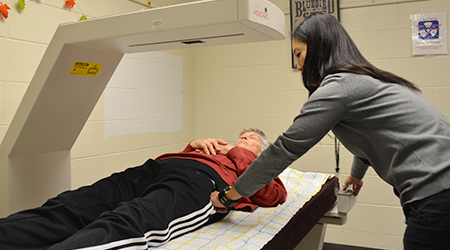
MTSU graduate student Saori Ishikawa, right, prepares Mary Belle Ginanni for a bone density scan. (MTSU photos by News and Media Relations)
Mary Belle Ginanni knows her body type, gender, family history and European heritage make her a candidate for osteoporosis.
That’s why she took part in a bone density study that is seeking more participants now at MTSU’s Alumni Memorial Gym.
“As we age, loss of balance is a major factor in falling, and, therefore, exercise is thought to help one to maintain balance,” said Ginanni, a Murfreesboro resident.
Saori Ishikawa, an MTSU graduate student, took the opposite approach to her research. Instead of studying the impact of exercise, she decided to examine the impact of sedentary behavior on bone density.
Ishikawa, who is working on her doctorate from the Department of Health and Human Performance, is studying postmenopausal women 65 years of age or older who are able to walk with or without the use of assistive devices.

Ishikawa points to the area on the hip bone that is scanned for her density study.
Ishikawa records each subject’s height and weight, asks a few health-related questions and uses a dual energy x-ray absorptiometry machine to scan the lumbar spine and the femoral neck area of the hip — the narrow neck between the round head of the femur, which fits into the hip socket, and the shaft of the bone — all at no charge to the participant.
Ginanni’s visit to campus took about 30 minutes. She and other study participants then wear a small, noninvasive monitoring device, similar to a pedometer, for a week.
“I couldn’t believe how easy it turned out to be,” Ginanni recalled. “The gizmo, which one wears over the hip bone of the dominant hip, is very small and caused no problem at all with my clothing.”
Participants document the times they take part in certain sedentary behaviors, including sleeping, lying down to watch TV, non-work-related sitting and work-related sitting.
“My study is an intervention where I communicate with the participants … and measure their activity level and sedentary behavior at the beginning and at the end of the study,” Ishikawa said.

Images of an unidentified participant’s hip, left, and lumbar spine scans help determine her degree of vulnerability to fractures and osteoporosis.
Ishikawa’s recommendations are not for vigorous, intense exercise, but for moderate lifestyle changes, such as walking while talking on the phone or washing dishes by hand instead of using the dishwasher.
“Such simple things as standing on one foot while in a checkout line or while standing at the sink is a good way to improve balance,” said Ginanni. “If necessary, you can touch a finger to the counter for reassurance.”
To volunteer for the free bone health study, or for more information, contact Ishikawa at 615-898-5545, 774-240-7517 or si2p@mtmail.mtsu.edu.
Ishikawa also will explain her bone density research in an interview to be aired on “MTSU On the Record” with host Gina Logue at 5:30 p.m. Monday, Dec. 17, and 8 a.m. Sunday, Dec. 23, on WMOT-FM (89.5 and www.wmot.org).
— Gina K. Logue (Gina.Logue@mtsu.edu)


COMMENTS ARE OFF THIS POST